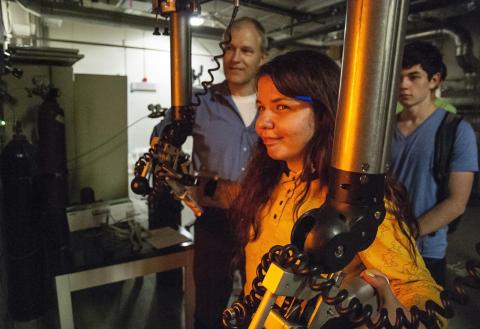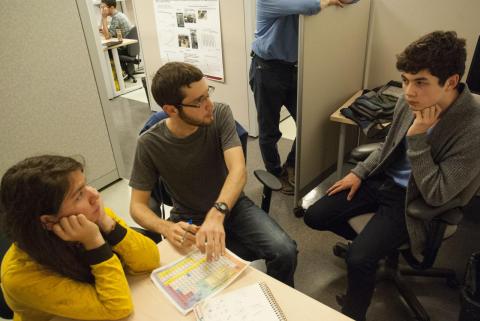

As part of the Emerging Aboriginal Scholars program, TRIUMF hosted two high school students for the last several weeks. Emerging Aboriginal Scholars is five-week summer camp for aboriginal students currently attending grades 9 to 12. The main purpose of this camp is to help students with their academics and for them to get work experience at the university. At either SFU or UBC, the students take 90 minutes of math and English every day, and three days a week they work with a research group in the area of their choice. The camps are offered by the Mathematics Departments at UBC and SFU along with the Pacific Institute for the Mathematical Sciences (PIMS). For more information about this program, visit their website here.
This is the 4th year that TRIUMF has been involved with the program, this year hosting two students, Genevieve Capilano from North Vancouver, and Liam Gamble from Prince Rupert. During their stay at TRIUMF, they visited with the Communications Office, the TUDA experiment (with Peter Machule), the CMMS (Gerald Morris and Iain McKenzie), and the laser-ion group (Jens Lassen). Below is their account of their stay at TRIUMF.
Liam Gamble writes:
"My experience at TRIUMF was truly an eye opening opportunity. I was able to see a large variety of things that regular people don’t get to see. Many things that people don’t even know exist. I thoroughly enjoyed going around a meeting the different physicists and having them explain their work to me. I learned a huge variety of things during my time here, from the function of the cyclotron to the medical treatment available to the public. I particularly enjoyed when I was able to just sit down with some physicists during their experiment and talk about what they did day in and day out. It was inspirational to see people that have been going to school for ten or more years on the job working, and thriving in their respective fields. I feel that my time at TRIUMF has really shown me how endless physics really is. There were so many things I still have yet to learn about physics and science in general. This is what excites me so much about it. The possibilities are truly endless. No matter how much one learns about the universe, there will always be more to learn. Many people do not appreciate the science that drives their modern lives, and I think that even if you take a tour of the facility, you can learn at least one thing that can change your perspective on modern life. I would like to thank all of the people I was able to work with, and who showed me there work, or around the labs. This was truly an amazing opportunity, that one simply could not pass up and I am glad I didn't."
Genevieve Capilano writes:
"My name is Genevieve Capilano and for this summer I registered for this UBC camp called “Emerging Aboriginal Scholars”; little did I know that I was to be signed up for the best work experience job I think was ever created (in BC at least). “TRIUMF” as you probably know, is Canada’s national laboratory for particle and nuclear physics. I felt ever so grateful being one of the two people selected for this particular program.
The first day I was fascinated at the physics lecture me and my fellow scholar Liam received the luxury of observing. A physicist was pitching an idea of an experiment to other scientists of numerous sorts to convince to them that her experiment was worth production.
As well as the lecture, we had the privilege of a tour around TRIUMF with dosimeters to ensure our safety regarding radiation intake (which really is nothing to worry about at all, just standard protocol).
Awestruck through the entire experience, from paperclips standing up by themselves due to the magnetic field to the TUDA. TUDA stands for TRIUMF Detector UK Array. To give probably the simplest way of explaining the experiment (and honestly my only way), its where they recreate a supernova. Sounds complicated but the physicists are using tiny masses, although you are probably questioning how they would do that on earth; as did I. Peter, a lovely physicist engineer we got to meet, explained to us that they used ethanol and water to recreate spaces’ kinetic energy that would allow the compartment that the experiment would take place to be cooled down. Then the scientists would shoot Sodium to Helium to recreate the star explosion (not the other way around, specifically in that order or else it would be next to impossible to do). A designed complex machine would then count the number of taps that would occur on specifically the Silicon part of the device, where then the data recorded would be sent to the control room that is made of copper so the magnetic field wouldn’t interfere with the computers. With this experiment scientists study the elements that are involved in a supernova and the elements that can be created during one.
A fact I found quite unbelievable was that Helium is going scarce on our planet. So not only do humans dilute Helium we use in balloons now a days, we attempt to recycle it as well. Which would take place in the Beta-NMR (which with the TUDA would be located in the ISAC building). So to explain this one, imagine a thermos with a layer of liquid nitrogen to contain radiant helium in the middle of the “thermos” at a temperature of 4 Kelvin. Then this vacuum that shoots into a pipe with four magnets, called superconductors with liquid nitrogen around the walls of the pipes (two positive and two negative) to steer this stream of particles on course to the compressor shack. In the compressor shack when it’s being compressed the heat that was added from it being transported to the ISAC building to the gas shack from the earth’s kinetic energy would be reduced.
The Cyclotron is a complex machine made of Aluminum and Titanium that produces protons that are accelerated to 500,000 electron Volts (eV), which is 3/4 of the speed of light. The Cyclotron is connected to pipes which the scientists call beam lines. Beam lines contain beams of particles under cement to block radiation (special cement engineered to do such a job). When the protons in the beam line hit target they make muons, which live for 2.2 microseconds (this all occurs under cement for safety). Then the selected sample would go to Hitime Spectrometer. The muons decay into positrons (a type of antimatter). Then a machine operated by the Cyclotron can find out their magnetic field inside the material.
On one of our many awesome tours we got to see the Detector Facility Lab where scientists build and test detectors. Detectors can look at particles in beams. Peter or maybe Iain was mentioning this experiment they have in Japan called TREK that does a time reversal experiment with Kaons. Also in the Detector Facility Lab we were told about the ATLAS, which I thought was radical. Geneva discovered the Higgs particle (was an international experiment with numerous scientist uniting for this experiment and research but was located in Geneva). So to explain the ATLAS with another analogy, it is like a onion, a very expensive complex onion a number of intelligent scientists created. It detects electron positrons expose to electron (positrons and electrons can be a same pair but with different charges). With the ATLAS the scientist could play a game of ‘guess that sample’ or some other sort of catchy clever name (someone else can come up with that) where only one scientist knows what sample they put into the ATLAS while the other scientists use the many layers of the onion-like ATLAS technology to collect data and find out which sample the original scientist put into ATLAS.
Another amazing human created experiment they made at TRIUMF that I was lucky to see was the Polarizer. The sample at the time was 8Li+ ions and generates a nuclear spin polarization by first adding one electron to make neutral 8Li0 atoms and then a laser beam shines on it to finish the polarization. Then lastly it collides with Helium gas to take an electron turning it back to 8Li+ but now is polarized. This all occurs in approximately 1 microsecond. Speed of light is approximately 300,000 km/second.
I could go on for days with the knowledge TRIUMF has filled my neurons with; but unfortunately I’m afraid this was supposed to be a short essay. I hope this has inspired whomever is reading it to pursue their dreams preferably science but if not, more room for me and the other people fascinated by it."
